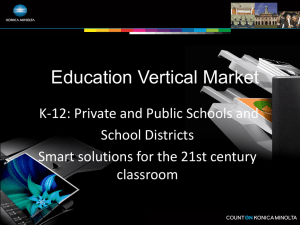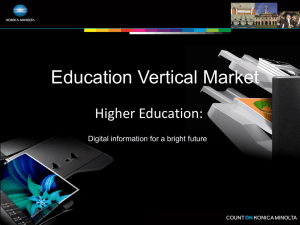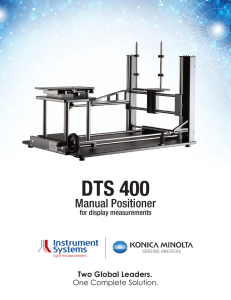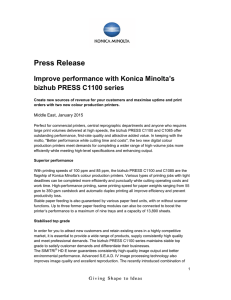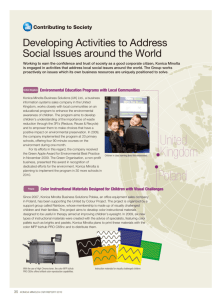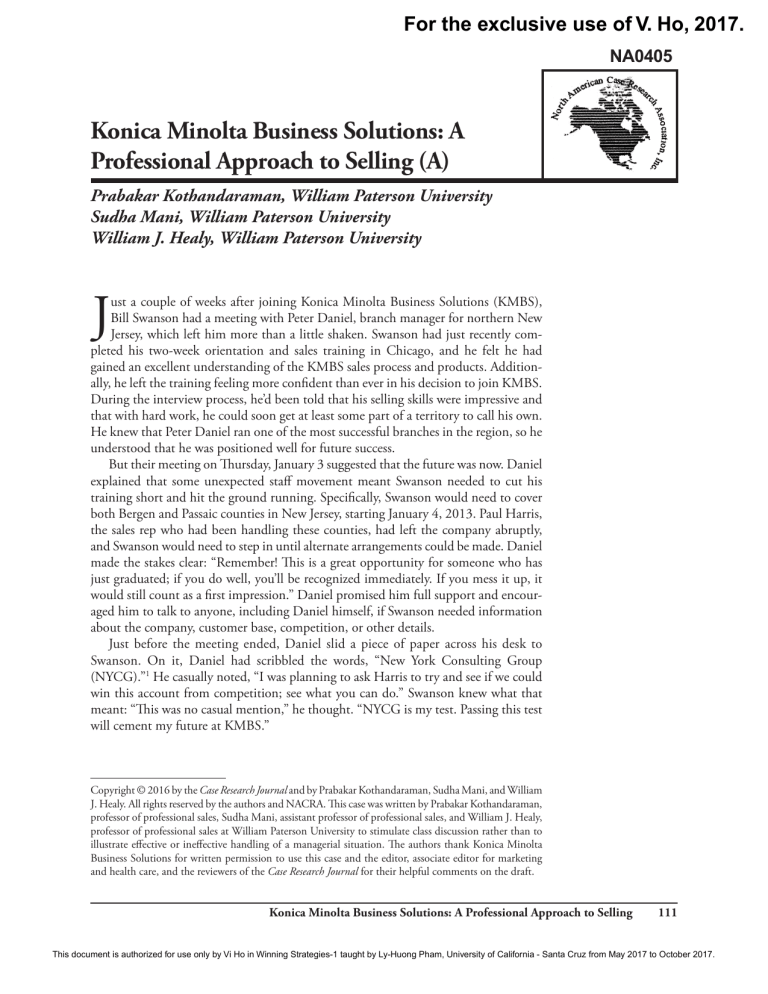
For the exclusive use of V. Ho, 2017. NA0405 Konica Minolta Business Solutions: A Professional Approach to Selling (A) Prabakar Kothandaraman, William Paterson University Sudha Mani, William Paterson University William J. Healy, William Paterson University J ust a couple of weeks after joining Konica Minolta Business Solutions (KMBS), Bill Swanson had a meeting with Peter Daniel, branch manager for northern New Jersey, which left him more than a little shaken. Swanson had just recently completed his two-week orientation and sales training in Chicago, and he felt he had gained an excellent understanding of the KMBS sales process and products. Additionally, he left the training feeling more confident than ever in his decision to join KMBS. During the interview process, he’d been told that his selling skills were impressive and that with hard work, he could soon get at least some part of a territory to call his own. He knew that Peter Daniel ran one of the most successful branches in the region, so he understood that he was positioned well for future success. But their meeting on Thursday, January 3 suggested that the future was now. Daniel explained that some unexpected staff movement meant Swanson needed to cut his training short and hit the ground running. Specifically, Swanson would need to cover both Bergen and Passaic counties in New Jersey, starting January 4, 2013. Paul Harris, the sales rep who had been handling these counties, had left the company abruptly, and Swanson would need to step in until alternate arrangements could be made. Daniel made the stakes clear: “Remember! This is a great opportunity for someone who has just graduated; if you do well, you’ll be recognized immediately. If you mess it up, it would still count as a first impression.” Daniel promised him full support and encouraged him to talk to anyone, including Daniel himself, if Swanson needed information about the company, customer base, competition, or other details. Just before the meeting ended, Daniel slid a piece of paper across his desk to Swanson. On it, Daniel had scribbled the words, “New York Consulting Group (NYCG).”1 He casually noted, “I was planning to ask Harris to try and see if we could win this account from competition; see what you can do.” Swanson knew what that meant: “This was no casual mention,” he thought. “NYCG is my test. Passing this test will cement my future at KMBS.” Copyright © 2016 by the Case Research Journal and by Prabakar Kothandaraman, Sudha Mani, and William J. Healy. All rights reserved by the authors and NACRA. This case was written by Prabakar Kothandaraman, professor of professional sales, Sudha Mani, assistant professor of professional sales, and William J. Healy, professor of professional sales at William Paterson University to stimulate class discussion rather than to illustrate effective or ineffective handling of a managerial situation. The authors thank Konica Minolta Business Solutions for written permission to use this case and the editor, associate editor for marketing and health care, and the reviewers of the Case Research Journal for their helpful comments on the draft. Konica Minolta Business Solutions: A Professional Approach to Selling 111 This document is authorized for use only by Vi Ho in Winning Strategies-1 taught by Ly-Huong Pham, University of California - Santa Cruz from May 2017 to October 2017. For the exclusive use of V. Ho, 2017. The Print and Copy Industry Xerography is a dry photocopying technique, invented by Chester Carlson in 1938 in Queens, New York. The first commercial copier, the Xerox 914, entered the market in 1959.2 Three companies—Xerox, Kodak, and IBM—dominated the copier market in the early 1970s, but Japanese manufacturers including Canon, Minolta, and Ricoh entered the U.S. market in the mid-1970s.3 Since that time, the market had evolved considerably. In particular, the emergence of multifunctional peripherals (MFPs), which combined copy, print, scan, and fax functions, largely remade the industry. By combining the functionalities of printing and photocopying, MFPs appealed to a wide audience from the moment they entered the field in the late 1990s. In turn, players from both traditional photocopier (e.g., Xerox) and printing (e.g., HP) industries sought to compete in this space. Growth came from companies that aimed to support the complete business process, rather than dedicated, paper-based output devices. Cost saving opportunities also drove MFP growth significantly, while sales relationships further encouraged its adoption.4 Sales representatives learned to build trust and provide extensive customer support to improve user experiences. The market was not without controversy, however. For example, starting in 2002, all photocopiers and MFPs began to include hard disk drives; therefore, the documents duplicated using these copiers were retained in their hard drives. A televised report by CBS in 2010 cautioned businesses and consumers about “Digital Copiers Loaded with Secrets.”5 The threat shook finance, banking, and other personal service industries, in which service providers faced the real threat that they could not meet their commitments to protect their own clients’ privacy and confidentiality. In 2009, a U.S. International Trade Commission Report6 suggested classifying MFPs as either printer-centric or photocopying-centric. Printer-centric MFPs usually catered to low-volume output and came to be known popularly as A4, identifying them by the A4 size paper (8½˝ × 11˝) that is commonly used in business documentation. With origins in photocopiers, A3 MFPs instead could accommodate bigger (11˝ × 17˝), tabloid-sized paper. In addition, these A3 MFPs offered greater ability to handle substantial volume and speed and could provide black-and-white or color printing. Color steadily grew to overtake black-and-white machines, as sales of KMBS’s A3 color MFPs indicated (See Exhibit A-1). 112 Case Research Journal • Volume 36 • Issue 1 • Winter 2016 This document is authorized for use only by Vi Ho in Winning Strategies-1 taught by Ly-Huong Pham, University of California - Santa Cruz from May 2017 to October 2017. For the exclusive use of V. Ho, 2017. Index - Sales in Units Exhibit A-1: U.S. Sales of KMBS A3 MFPs 120 100 80 57 61 61 60 BW 40 39 43 48 FY2010 FY2011 FY2012 20 0 Color Year * Base index: FY2010 = 100 Source: KMBS 2013 Annual Report. Taking sales of color and black-and-white MFPs together, Canon led the U.S. market with a 28.9 percent share, followed by KMBS with 19.7 percent. Ricoh finished third, with 12.8 percent of the market. Color MFPs accounted for 42 percent of A3 sales, and the rest were black-and-white machines. By 2012, the A3 MFP segment was growing at 10 percent (see Exhibit A-2). And, in the United States, KMBS enjoyed a 20 percent share, making it the third largest player in this growing segment (see Exhibit A-3). Exhibit A-2: KMBS Projections for U.S. A3 MFP Market 900 60% 50% 700 600 40% 500 30% 400 300 20% 200 BW Color Color ra4o 10% 100 0 Per cent of Color Market Size in Thousands of Units 800 2010 2011 2012 2013 2014 2015 2016 0% Source: Printers and copiers market grows 7 percent: Gartner. (2012, September 21). Press Trust of India. Retrieved May 28, 2015, from http://gadgets.ndtv.com/laptops/news/printers-and-copiers-marketgrows-7-percent-gartner-270460. Konica Minolta Business Solutions: A Professional Approach to Selling 113 This document is authorized for use only by Vi Ho in Winning Strategies-1 taught by Ly-Huong Pham, University of California - Santa Cruz from May 2017 to October 2017. For the exclusive use of V. Ho, 2017. Exhibit A-3: A3 Color MFP Market Share Source: KMBS 2013 Annual Report. KMBS Konica Minolta Business Solutions, USA, Inc. (KMBS) was part of Konica Minolta Inc., a world leader in providing print and copy services to corporations of all sizes. Globally, it operated in 41 countries and employed about 41,800 people. Its 2012 global revenues were US$7.44 billion (or ¥767,879 million; ¥100 = $$0.97),7 which represented an increase of 1.3 percent over its 2011 sales.8 Its net income declined by 21.1 percent during that period though, to $198.1 million. Its business lines covered the entire gamut of printing and copying using MFPs and other equipment associated with imaging in a variety of industries. Konica Minolta, Inc., also supplied materials required for printing and imaging, such as special purpose film. The origins of the company came from two branches. In 1873, Konica’s Japanese founder Rokusaburo Sugiura began selling photographic and lithographic equipment in Tokyo, Japan.9 After three decades of operations, his company introduced Japan’s first brand name camera, the Cherry Handheld. Separately, the forerunner of the Minolta Corporation, the Japan Germany Photo Company, was incorporated in 1928 to manufacture cameras. Over the years, these two start-ups blossomed into the Konica Corporation and the Minolta Corporation. They both expanded their product ranges and achieved many firsts in the industry, including Sakura Color Film and the world’s first 35 mm autofocus compact camera. Konica established its first U.S. office in 1956 in Philadelphia, before moving its headquarters to Ramsey, New Jersey. Eventually, the companies merged in 2003 to form the Konica Minolta Holdings, Inc. In 2004, Konica Minolta introduced its “bizhub” office equipment brand 114 Case Research Journal • Volume 36 • Issue 1 • Winter 2016 This document is authorized for use only by Vi Ho in Winning Strategies-1 taught by Ly-Huong Pham, University of California - Santa Cruz from May 2017 to October 2017. For the exclusive use of V. Ho, 2017. and released its first high-speed digital color MFP, the bizhub PRO C6500. By 2006, Konica ceased selling cameras in the United States and began to focus solely on business and print solutions. Thus by 2012, it organized its business into four groups: Business Solutions, Medical Imaging, Measuring Instruments, and Planetarium (see http://konicaminolta.us/ for details). In 2013, the company name changed to Konica Minolta, Inc., described on its website as follows:10 Konica Minolta Business Solutions U.S.A., Inc. (Konica Minolta) is a leader in advanced document management technologies, application solutions, and IT Services from the desktop to the print shop. The company is focused on delivering complete solutions that include the manufacturing, servicing and sales of office systems, digital presses, production print systems, printers, vertical application solutions, and related services and supplies. The Business Solutions division maintained a range of products under the bizhub umbrella brand, which it grouped into three categories: office systems, print production, and printers. The office systems offered printing, copying, and scanning functions, with simple on-screen controls, in the form of color multifunction, black-and-white multifunction, or compact multifunction machines.11 These office system products targeted small, medium, and large businesses and were built to handle continuous, heavy print loads. Print production products offered “revolutionary color image, ultrahigh speed B&W output, and pro-quality finishing.”12 In addition, the bizhub brand appeared on all-in-one and single-function printers in both desktop and network versions. Digital heavy-duty color and black-and-white presses formed the bedrock of print production; standalone business and home-office printers with advanced features came under the “printer” heading.13 The tag line for this category promised, “From Desktop to Print Shop.” Furthermore, KMBS sold wide-format printers and scanners under the KIP brand name. KMBS offered a number of services that enabled it to offer end-to-end printing solutions. Its Optimized Print Services combined consulting, hardware, software integration, and services as seamless solutions for clients. These clients primarily sought turnkey solutions, rather than having to hire individual consultants to design and execute their varied print solutions. Among its staff, KMBS employed solution design specialists who studied the needs of potential clients closely and recommended suitable, configured solutions from the KMBS range of products. It also recognized that companies needed to integrate their print solutions with software, so KMBS brought in IT specialists to consult and address connectivity with the clients’ own IT professionals. By supporting applications, such as cost accounting, data conversion, and security, KMBS also could integrate these services into the total solutions offered to clients. Over the years, KMBS had invested extensively in new manufacturing and green technology, working toward greater sustainability. In the United States, KMBS had achieved a large customer base in healthcare, education, and legal sectors; it also supplied printing solutions to small and large banks. As a new hire, Bill Swanson had learned most of this information during the orientation program. He also had spent much of his spare time during the training pouring over the KMBS website and brochures. He knew that each salesperson in the company had a “pitch book,” designed to meet his or her informational and marketing needs while calling on potential clients. Swanson knew he would have to come up with his own pitch book quickly. Although he was glad to have a goal, Swanson also was nervous. “I expected that I’d be asked to make cold calls during my first few days Konica Minolta Business Solutions: A Professional Approach to Selling 115 This document is authorized for use only by Vi Ho in Winning Strategies-1 taught by Ly-Huong Pham, University of California - Santa Cruz from May 2017 to October 2017. For the exclusive use of V. Ho, 2017. at KMBS,” he thought. “Instead, I have a strategic prospect. I need to find as much information about NYCG as I can, as fast as I can!” NYCG A global accounting and consulting firm, registered in Delaware and headquartered in Hartford, Connecticut, New York Consulting Group (NYCG) employed more than 97,500 people around the world. The international arm was incorporated in Delhi, India, and operated in nearly 100 countries. In 2012, NYCG’s global revenues were $12.2 billion. The firm’s annual growth, in dollar terms, was a healthy 6 percent, and it enjoyed an impeccable reputation in the marketplace. Partners regularly provided opinions on proposed tax legislation to U.S. and global governments. Its clients included leading business corporations, non-profit organizations, and sovereign governments. According to NYCG, its clients looked to it for a consistent standard of service, based on professional expertise, industry insight, and local knowledge. Globally, NYCG was organized along the countries served, industry verticals, and the professional fields of audit, tax, and advisory. In the United States NYCG employed nearly 27,000 people and operated out of ninety-two field offices in major cities (Exhibit A-4). The consulting firm’s major operations were located in Wayne, New Jersey. In 2012, its revenue in the United States was $4.9 billion (Exhibit A-5). Its mission was to turn knowledge into value, for the benefit of its clients. Although an accounting and audit firm, NYCG’s primary focus since the turn of the century had been on providing value to clients using NYCG’s proprietary knowledge, which resided in its employees and their collective experiences. In its pursuit to add value for clients, NYCG constantly was striving to maintain the highest levels of public trust, integrity, and transparency. Along with its emphasis on delivering high quality professional services, NYCG publicly committed itself to working with clients and other global organizations on green initiatives that focused on eco-friendliness and sustainability. The 2012 annual report noted: In the two years since launching our Global Green Initiative, NYCG-International achieved a combined 19 percent reduction in net emissions per full-time equivalent employee. We estimate the cumulative emission savings to be equal to removing 55,000 cars from the road for one year. The leadership of NYCG International is seeking an additional 10 percent reduction by 2016. 116 Case Research Journal • Volume 36 • Issue 1 • Winter 2016 This document is authorized for use only by Vi Ho in Winning Strategies-1 taught by Ly-Huong Pham, University of California - Santa Cruz from May 2017 to October 2017. For the exclusive use of V. Ho, 2017. Exhibit A-4: NYCG Employees, United States 2011 2012 19725 19245 5139 1743 5202 1931 Partners Professional Staff Administra:ve staff Source: NYCG 2013 Annual Report. Exhibit A-5: NYCG Revenue, United States (in billions) 2011 2012 2.3 2.3 1.2 1.1 Audit Tax 1.2 1.4 Advisory Source: NYCG 2013 Annual Report. Printing and Copying at NYCG In 2010, U.S. corporations still stored most of their information on paper. Concerns over hacking and the reliability of electronic storage had slowed the adoption of socalled paperless offices. Most people also preferred paper reports and statements, for their convenience benefits. An online survey found that 82 percent of Americans preferred paper statements, which seemed more official and trustworthy.14 In the same survey, 78 percent of the 600 people interviewed said they preferred paper over electronic reports because they considered paper more “confidential.” Finally, 77 percent asserted that electronic reports could be altered without their knowledge, making them less trustworthy. Reflecting this trend, NYCG was a massive consumer of printing and Konica Minolta Business Solutions: A Professional Approach to Selling 117 This document is authorized for use only by Vi Ho in Winning Strategies-1 taught by Ly-Huong Pham, University of California - Santa Cruz from May 2017 to October 2017. For the exclusive use of V. Ho, 2017. copying services, as it constantly sought to create new knowledge. Furthermore, its commitment to confidentiality and customer service meant that it needed a large, in-house printing operation that would meet the needs of its sizable professional staff and clients. Daniel’s History with NYCG’s Print and Copying Solution Purchases Prior to joining KMBS, Peter Daniel worked at Canon for nearly fifteen years. Since his early days at Canon, Daniel had been thinking about the NYCG account, which was both substantial and prestigious. In 2000, Xerox Corporation handled NYCG’s printing and copying needs with an estimated deal size of $10–$20 million. Daniel, who was a senior account manager at that time, knew that the Xerox contract would be up for renewal in 2001. Through constant follow-up with NYCG, he also became aware of the variety of issues facing NYCG, so he negotiated to place fifty of Canon’s machines in NYCG’s Virginia office on a trial basis. Three months into the trial, Canon was invited to submit a proposal to meet all of NYCG’s needs. As Daniel recalled the conversation, he was told to “conduct an analysis as to what the outcome will be if we replaced every one of the Xerox machines with Canon products.” At 10:00 a.m. on September 12, 2000, Daniel dropped off Canon’s proposal for NYCG. By 4:00 p.m., NYCG called back to inform him that Canon had won its business. Canon was to supply all of NYCG’s requirements, though Hewlett-Packard (HP) managed to obtain orders for some low capacity black-and-white printers to be installed in individual offices. It was rumored that HP, one of NYCG’s larger clients, had convinced its client partners at NYCG to retain it as a print service supplier. However, Canon secured all the business at NYCG’s dedicated print shops. Daniel, who joined the KMBS team in 2010, wanted the NYCG account again! Thus, Swanson learned much of what was known about how Canon grabbed the account from Xerox first-hand, from the person who managed the shift. But by 2013, much might have changed at NYCG. Swanson believed he was starting with essentially a clean slate. “I need a plan,” he reminded himself. “I really have to do my homework on NYCG.” With this goal in mind, he began drafting a plan to gather information about the prospect that he had been dealt in his first few days with KMBS. Notes 1. Name of the client and some of the detailed numbers have been disguised to protect the identity of the client. 2. “Xerox Innovation History.” (n.d.) Retrieved February 18, 2016, from http:// www.xerox.com/innovation/xerox-innovation-history/enus.html. 3. Boulton, W. (1995). “The Plain Paper Copier Industry.” Retrieved from http:// www.auburn.edu/~boultwr/copiers.pdf. 4. Kmetz, Keith, Alyson Frasco, and Sahaja Sarathy (2013), “IDC MarketScape: U.S. Smart Multifunction Peripheral 2013 Vendor Assessment.” 5. Keteyian, A. (2010, April 19). “Digital Photocopiers Loaded With Secrets.” Retrieved February 18, 2016, from http://www.cbsnews.com/8301-18563_ 162-6412439.html. 6. Torsekar, M., Reed, M., and Anderson, M. (2015, May). “Multifunction Products.” Retrieved from http://www.usitc.gov/publications/332/ITS_3.pdf. 118 Case Research Journal • Volume 36 • Issue 1 • Winter 2016 This document is authorized for use only by Vi Ho in Winning Strategies-1 taught by Ly-Huong Pham, University of California - Santa Cruz from May 2017 to October 2017. For the exclusive use of V. Ho, 2017. 7. “Historical Exchange Rates|OANDA.” (n.d.) Retrieved April 5, 2015, from http://www.oanda.com/currency/historical-rates/. 8. “March 2012 Consolidated Financial Results Highlight|KONICA MINOLTA.” (n.d.) Retrieved February 18, 2016, from http://www.konicaminolta.com/ about/investors/fr/f24_4q.html. 9. “Over a Century of Innovation.” (n.d.) Retrieved February 18, 2016, from http://kmbs.konicaminolta.us/wps/portal/web/home/about/our-history. 10. “Konica Minolta Company Information.” (n.d.) Retrieved February 18, 2016, from http://kmbs.konicaminolta.us/wps/portal/web/home/about/company. 11. “Konica Minolta Multifunction Solutions.” (n.d.) Retrieved June 2, 2015, from http://kmbs.konicaminolta.us/wps/portal/web/home/products/office-systems. 12. “Konica Minolta Login.” (n.d.) Retrieved June 2, 2015, from http://kmbs. konicaminolta.us/wps/portal/web/home/products/production-print. 13. “Konica Minolta Business Solutions.” (n.d.) Retrieved February 18, 2016, from http://kmbs.konicaminolta.us/wps/portal/web/home/home/businesssolutions. 14. “TRU Market Research & Analysis.” (n.d.) Retrieved February 18, 2016, from http://trugroup.com/tru-market-research. Konica Minolta Business Solutions: A Professional Approach to Selling 119 This document is authorized for use only by Vi Ho in Winning Strategies-1 taught by Ly-Huong Pham, University of California - Santa Cruz from May 2017 to October 2017.

